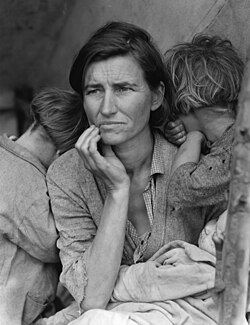Vintage print

Vintage print je první fotografie, kterou fotograf – autor zhotoví vlastnoručně z vyvolaného vlastního negativu.
Popis
Vintage printy se považují za originál uměleckého díla, jinak je možné získat libovolné množství kopií z jednoho negativu. Většinou to znamená, že tyto originály jsou podepsány autorem. Na trhu s uměním se tento termín používá ještě pro označení starých tisků – obzvláště z počátku 20. a 19. století například pro litografie (kamenotisky), lepty, rytiny nebo oceloryty. Od sedmdesátých let dvacátého století do této kategorie lze zahnout také metodu cromalin.
Tisky, které vznikly do roku 1800, se nazývají tisky starých mistrů (anglicky Old master prints).
Zajímavé příběhy
Matka přistěhovalkyně

Na konci 60. let našel Bill Hendrie původní originály Matky přistěhovalkyně (Migrant Mother) a 31 dalších vintage printů Dorothey Langové v kontejneru v San José.[1] Po smrti Hendrieho a jeho ženy tyto fotografie znovuobjevila při vyklízení domova rodičů jejich dcera Marian Tankersley.[1]
V roce 1998 se vyretušovaná fotografie Matky dostala na známku o nominální hodnotě 32 centů americké poštovní služby u příležitosti oslavné série 30. let dvacátého století.[2] Tisk známky byl neobvyklý, neboť dcery Katherine McIntosh (vlevo) a Norma Rydlewski (v náručí Thompsonové) byly ještě v době tisku naživu a je velmi neobvyklé pro poštovní služby tisk známky s podobiznami jednotlivců, kteří nejsou mrtví nejméně 10 let.[3]
Ve stejném měsíci, kdy byla vydána americká známka, byla na aukci Sotheby's v New Yorku prodána fotografie s ručně psanými poznámkami Langeové a jejím podpisem za 244 500 dolarů.[4] V listopadu 2002 se prodal vintage print Matky od Dorothey Langeové prodal na New York Christie za 141 500 dolarů.[5] V říjnu 2005 anonymní kupec vyplatil 296 000 dolarů v Newyorské Sotheby za nově objevený snímek Langeové. Jeho cena celkem šestkrát překročila původní nabízenou sumu.[1]
Odkazy
Reference
- ↑ a b c Neff, Cynthia. (October 20, 2005) The Tribune (San Luis Obispo) Face of hard times has a big payday. Dorothea Lange's famous 'Migrant Mother' Depression photograph, taken in Nipomo, and others collect almost $300,000 at auction.
- ↑ Bennett, Lennie. (May 11, 2008) St. Petersburg Times A mother's strength knows no bounds. Archivováno 6. 6. 2008 na Wayback Machine. Section: Latitudes; str. 2L.
- ↑ Garchik, Leah. (October 6, 1998) San Francisco Chronicle Stamp honors ERA, not the people. Section: Daily datebook; str. B10. (poznámka: Ruby Sprague (on the right in the stamp) had died of cancer prior to the stamp printing.)
- ↑ Yi, Matthew. (November 22, 1998) Tulsa World Girl in famous Depression-era photo piqued. Section: News; str. A11.
- ↑ Schoettler, Carl. (November 12, 2002) Daily Press (Virginia) A true picture of hard times. Photo of poverty sells for a stack of riches. Section: Life; str. D1.
Média použitá na této stránce
Portrait shows Florence Thompson with several of her children in a photograph known as "Migrant Mother". The Library of Congress caption reads: "Destitute pea pickers in California. Mother of seven children. Age thirty-two. Nipomo, California." In the 1930s, the FSA employed several photographers to document the effects of the Great Depression on the population of America. Many of the photographs can also be seen as propaganda images to support the U.S. government's policy distributing support to the worst affected, poorer areas of the country. Lange's image of a supposed migrant pea picker, Florence Owens Thompson, and her family has become an icon of resilience in the face of adversity. However, it is not universally accepted that Florence Thompson was a migrant pea picker. In the book Photographing Farmworkers in California (Stanford University Press, 2004), author Richard Steven Street asserts that some scholars believe Lange's description of the print was "either vague or demonstrably inaccurate" and that Thompson was not a farmworker, but a Dust Bowl migrant. Nevertheless, if she was a "Dust Bowl migrant", she would have left a farm as most potential Dust Bowl migrants typically did and then began her life as such. Thus any potential inaccuracy is virtually irrelevant. The child to the viewer's right was Thompson's daughter, Katherine (later Katherine McIntosh), 4 years old (Leonard, Tom, "Woman whose plight defined Great Depression warns tragedy will happen again ", article, The Daily Telegraph, December 4, 2008) Lange took this photograph with a Graflex camera on large format (4"x5") negative film.[1]

